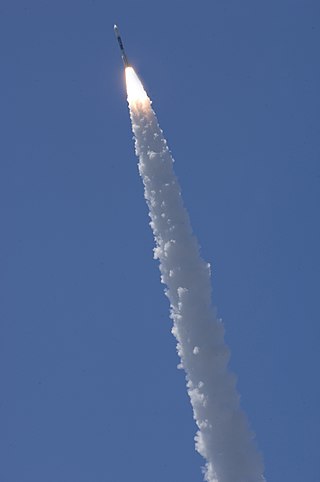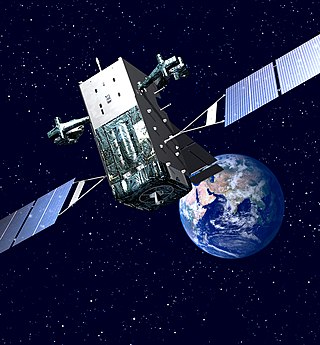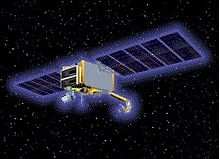
The Strategic Defense Initiative (SDI), nicknamed the Star Wars program, was a proposed missile defense system intended to protect the United States from attack by ballistic strategic nuclear weapons. The concept was announced on March 23, 1983, by President Ronald Reagan, a vocal critic of the doctrine of mutually assured destruction (MAD), which he described as a "suicide pact". Reagan called upon American scientists and engineers to develop a system that would render nuclear weapons obsolete. Elements of the program reemerged in 2019 with the Space Development Agency (SDA).

The Defense Support Program (DSP) is a program of the United States Space Force that operated the reconnaissance satellites which form the principal component of the Satellite Early Warning System used by the United States.
Lockheed Martin Space is one of the four major business divisions of Lockheed Martin. It has its headquarters in Littleton, Colorado, with additional sites in Valley Forge, Pennsylvania; Sunnyvale, California; Santa Cruz, California; Huntsville, Alabama; and elsewhere in the United States and United Kingdom. The division currently employs about 20,000 people, and its most notable products are commercial and military satellites, space probes, missile defense systems, NASA's Orion spacecraft, and the Space Shuttle external tank.

Space Systems Command (SSC) is the United States Space Force's space development, acquisition, launch, and logistics field command. It is headquartered at Los Angeles Air Force Base, California, and manages the United States' space launch ranges.

The Missile Defense Alarm System, or MIDAS, was a United States Air Force Air Defense Command system of 12 early-warning satellites that provided limited notice of Soviet intercontinental ballistic missile launches between 1960 and 1966. Originally intended to serve as a complete early-warning system working in conjunction with the Ballistic Missile Early Warning System, cost and reliability concerns limited the project to a research and development role. Three of the system's 12 launches ended in failure, and the remaining nine satellites provided crude infrared early-warning coverage of the Soviet Union until the project was replaced by the Defense Support Program. MiDAS represented one element of the United States's first generation of reconnaissance satellites that also included the Corona and SAMOS series. Though MIDAS failed in its primary role as a system of infrared early-warning satellites, it pioneered the technologies needed in successor systems.

The 2nd Space Warning Squadron is part of the Space Delta 4 at Buckley Space Force Base, Colorado. It operates the Space-Based Infrared System satellites conducting global monitoring for significant infrared events.

The 11th Space Warning Squadron is a United States Space Force missile warning squadron, located at Buckley Space Force Base, Colorado.
The Space Tracking and Surveillance System was a pair of satellites developed by the United States Missile Defense Agency (MDA) to research the space-based detection and tracking of ballistic missiles. Data from STSS satellites could allow interceptors to engage incoming missiles earlier in flight than would be possible with other missile detection systems. The STSS program began in 2001, when the "SBIRS Low" program was transferred to MDA from the United States Air Force. In December 2002, SBIRS Low Research & Development was renamed Space Tracking and Surveillance System (STSS).

USA-205, also known as Space Tracking and Surveillance System-Advanced Technology Risk Reduction (STSS-ATRR), and previously as Block 2010 Spacecraft Risk Reduction is a satellite formerly operated by the United States Missile Defense Agency. It was launched to demonstrate new technology for missile detection early warning systems (MDEWS). The technology demonstrated on STSS-ATRR was used in the development of the Space Tracking and Surveillance System (STSS) part of the Space-Based Infrared System (SBIRS).

The Joint Tactical Ground Station (JTAGS) is the United States Space Force's element to United States Strategic Command's Theater Event System (TES). TES provides an integrated, in-theater, 24-hour overhead non-imaging infrared detection capability for processing and disseminating missile early warning, alerting, and cueing information data to combatant commanders and missile defense assets through the use of stereo processing of the Defense Support Program (DSP) satellite data.
USA-230, also known as SBIRS GEO-1, is a United States military satellite and part of the Space-Based Infrared System.

USA-241, also known as SBIRS GEO-2, is a United States military satellite and part of the Space-Based Infrared System.

An early warning satellite is a satellite designed to rapidly detect ballistic missile launches and thus enable defensive military action. To do this, these satellites use infrared detectors that identify the missile thanks to the heat given off by its engines during the propulsion phase.

USA-273, also known as SBIRS GEO-3, is a United States military satellite and part of the Space-Based Infrared System (SBIRS).
GPS Block IIIF, or GPS III Follow On (GPS IIIF), is the second set of GPS Block III satellites, consisting of up to 22 space vehicles. The United States Air Force began the GPS Block IIIF acquisition effort in 2016. On 14 September 2018, a manufacturing contract with options worth up to $7.2 billion was awarded to Lockheed Martin. The 22 satellites in Block IIIF are projected to start launching at the end of 2026, with launches estimated to last through at least 2034.

USA-282, also known as SBIRS GEO-4, is a United States military satellite and part of the Space-Based Infrared System.

While the United States Space Force gained its independence on 20 December 2019, the history of the United States Space Force can be traced back to the beginnings of the military space program following the conclusion of the Second World War in 1945. Early military space development was begun within the United States Army Air Forces by General Henry H. Arnold, who identified space as a crucial military arena decades before the first spaceflight. Gaining its independence from the Army on 18 September 1947, the United States Air Force began development of military space and ballistic missile programs, while also competing with the United States Army and United States Navy for the space mission.

The Space Development Agency (SDA) is a United States Space Force direct-reporting unit tasked with deploying disruptive space technology. A primary focus is space-based missile defense using large global satellite constellations made up of industry-procured low-cost satellites. The SDA has been managed by the United States Space Force since October 2022. By February 2024 the SDA had 33 satellites on orbit. SDA targets to have at least 1,000 satellites in low Earth orbit by 2026.
USA-315, also known as SBIRS GEO-5, is a military satellite developed as a part of the Space-Based Infrared System. The satellite aims to increase the capabilities of the United States Department of Defense in terms of missile defense and military intelligence.

USA-336, also known as SBIRS-GEO 6 , is a geostationary satellite operated by the United States Space Force. USA-336 forms part of the SBIRS High program.
















